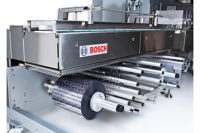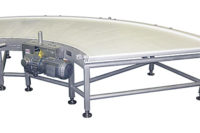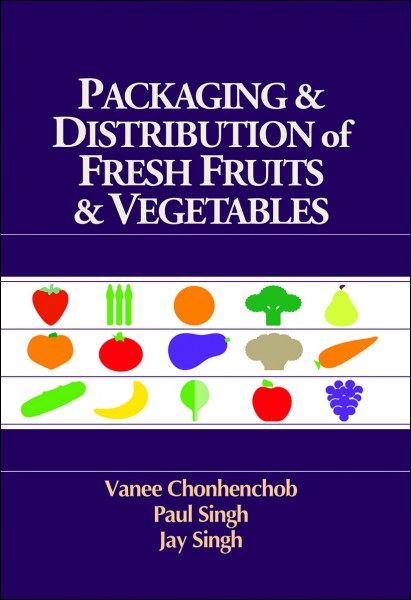Packaging update














Primary food packaging continues to evolve in response to growing consumer interest in product safety, resealability and portability. These issues are top-of-mind for bakers and snack manufacturers too, as are production and transportation costs, in-store visibility and display, recyclability and product traceability.
Many of today’s food producers are finding that flexible packaging meets their needs, as well as those of their customers and consumers. A recently released study on converted flexible packaging by The Freedonia Group reveals that demand for converted flexible packaging in the U.S. market is expected to increase 3.5% annually to more than $21 billion in 2017, or 9.1 billion lb.
This growth will be driven by the packaging market’s ongoing investment in specialty film and advanced materials for higher-value offerings that emphasize longer shelf life, performance features, source reduction and protection from outside contaminants, according to the Cleveland-based firm’s “Converted Flexible Packaging” report.
“The pouch market will continue to showcase above-average gains, penetrating segments that have once been considered the hallmarks of rigid packaging,” states the report. “Standup pouches offer the most promise for growth in converted flexible packaging, and a large variety of new pouches with specialty features has entered the retail market. Bolstering the pouch’s repeated gains over rigid alternatives have been new technology introductions that include innovative fitments and closures and more sophisticated resealable features, which bring higher value to pouches.
“The use of thinner film, fewer coextrusion layers and laminates, and a new focus on recyclable materials are driving sustainability efforts and lowering production and freight costs,” the report continues. “Many producers are considering mono-material structures that avoid the use of foil or other barrier materials, helping enhance production and potential recyclability. Advances in metalized and oriented films have improved both barrier and decorative qualities.”
Plastic- and paper-based bags, which represent the largest segment of converted flexible packaging, are not expected to grow as quickly as pouches, according to the study. Paper bags, on the other hand, are expected to remain a stable format.
Packaging components
Dow Performance Plastics, a business unit of The Dow Chemical Co., Midland, Mich., launched a number of new products in 2013 to enhance food packaging, including those used by bakers and snack manufacturers. “Our innovations for the year focus on improving packaging performance and increasing the sustainability of package manufacturing, with an emphasis on flexible packaging’s growing presence across all food segments,” says Nestor de Mattos, group marketing director for food and specialty packaging.
To that end, the company introduced new sealants for high-speed vertical form/fill/seal (vf/f/s) packaging lines to its ELITE Enhanced Polyethylene family. It added a new compatibilizing agent to the AMPLIFY Functional Polymers portfolio, which allows for more efficient production of multilayer films involving ethylene vinyl alcohol (EVOH) and polyamides for oxygen barrier. In addition, Dow’s AGILITY line of low-density polyethylene (LDPE) products is designed to increase throughput on blown film lines.
“Dow has heard loud and clear that reduction in packaging cost is critical,” de Mattos responds when asked about packaging challenges bakers and snack producers will face in the coming years. “But that does not necessarily mean simply choosing a cheaper resin to make a film. We focus on total cost of ownership, which includes using high-quality products to produce reliable packages that eliminate loss in the value chain. This also includes running equipment with materials that give great processing and reusing expensive materials whenever possible.”
Integrated closures
Meanwhile, Sonoco, Hartsville, S.C., introduced flexible packaging with SealTab integrated reclosure technology. “This innovative package was first commercialized with Pepperidge Farm Baked Naturals cracker chips and recently was expanded to Pepperidge Farm Goldfish Puffs,” explains Pete Gioldasis, division marketing manager, global flexible packaging.
The technology provides benefits to consumers as well as bakers and snack producers or other consumer packaged goods (CPGs). “Consumers want on-the-go convenience, portability and reclosure to aid in product containment and improved freshness,” Gioldasis says. “They also want packaging that’s easy to use. By providing an integrated reclose feature that meets all these needs, brands improve the consumer experience.”
The benefits to bakers, snack producers and other CPGs are plentiful, too. The reclosure feature is integrated into the bag’s wall using a pressure-sensitive adhesive and is precision-scored with a laser, so the film can run through existing packaging equipment, and easily integrate into existing manufacturing processes without negatively impacting production efficiencies. Because no application is required, manufacturers save time and money with no capital requirements.
“The tab score is registered with graphics, allowing more flexibility and maintaining brand integrity,” says Gioldasis. “The brand is in front of the consumer longer, since consumers are more likely to reclose and continue to use the bag rather than move the chips to a secondary storage container, helping drive repeat purchases.”
In addition, packaging with SealTab integrated reclosable technology enables users to differentiate themselves from their competitors. They also have the flexibility to modify the shape, size and location of the reclosure to accommodate a variety of package forms, including standup pouches, pillow bags and quad seal bags.
As for food packaging trends, Gioldasis says, “We’re beginning to see a shift in the conversation around sustainability. In the past, the focus around packaging has been primarily on source reduction, transportation, end of life, landfill avoidance, etc. Increasingly, the focus is shifting to reducing food waste. Studies have indicated that as much as 40% of food is wasted, so in-demand packaging will keep food from going stale longer or help reduce waste through better portion control.
“Additionally, production input costs such as ingredients and energy, are likely to continue increasing, so food producers will be challenged to meet ever-growing consumer demands for increased functionality without significantly increasing costs or requiring new capital investments. SealTab technology delivers on both of these trends.”
Clear Lam Packaging Inc., Elk Grove Village, Ill., developed a new package featuring the PrimaPak packaging system for John B. Sanfilippo & Son’s Flavor Tree Limited Edition Premium Dark Chocolate Pretzels. The patented and patent-pending technology is designed to replace heavy rigid packaging and improve shelf appeal. It achieves up to 70% weight savings compared to plastic jars, reduces warehousing demands and truck shipments, improves costs and enhances sustainability initiatives throughout the supply chain, according to Clear Lam.
To create a flexible package capable of being stacked and better protecting products inside, the company developed a new method of enhancing the package rigidity. The end result is a pop-up box shape with a resealable lid that opens easily, stays open, and reseals with a light touch. The finished package retains its shape, performs well during transport and stores well on retail shelves and in consumer pantries. It is made from a single roll of film on a PrimaPak bagging machine.
Sealed Air, Duncan, S.C., has developed Cryovac Multi-Seal FoldLOK resealable packaging, which features a tab near the top that consumers peel off to initially open the package. When they’re ready to store the remaining product, they simply fold the top of the bag over the strip and the materials stick together to seal the package. The pouch also has a gusseted bottom, enabling retailers to create stand-up product displays. Applications include nuts and trail mix.
Keep it zipped
Manteno, Ill.-based Zip-Pak, a division of Illinois Tool Works Inc. (ITW), featured its latest resealable closure technologies in September at FachPack 2013 in Nuremberg, Germany.
Sensus is the first in the Sensory Feedback Fasteners family of resealable closures; they feature performance characteristics that appeal to a consumer’s sense of sound, sight, smell or touch. The Sensus reclosure profile is specifically designed to create a tactile bumping sensation and audible clicking noise when the zipper is opened or resealed. It can be applied to most types of flexible packaging, regardless of pouch size; is well-suited for f/f/s machine applications; and is ideal for a wide range of flexible packaged products, including granola and salty snacks.
Vector Resealable Matrix Fastener is a proprietary, self-sealing matrix closure system that closes securely without precisely lining up the opposing segments. Because Vector closes on itself and has no end termination, it represents an easy-to-use alternative to traditional zipper profiles. It can be integrated into existing manufacturing lines with only minor modifications to machinery required, according to the company.
Slider Select is a cost-effective, ultra-compact slider system that has an ergonomically designed “clip” to enable easy opening and resealing by consumers of all ages. The zipper also features a leak-resistant profile and high inside-burst strength for enhanced package integrity and product protection.
The Zip360 resealable, flexible pouch has a wide opening that provides easy access to contents. It features a pour spout for easy product dispensing. The package format reseals two ways for neater stacking and easier access. It also accepts full-panel graphics for more visual impact at point of purchase.
Zip-Pak recently collaborated with TechniPac Inc. in Le Sueur, Minn., to develop a resealable package for GIANTS Snacks’ GIANTS Sunflower Seeds. GIANTS Snacks requested a package that was pourable, with a half close, and a zipper closure to secure and protect the contents. The final package featured a Pour & Lok closure solution and a hermetic packaging barrier to preserve the freshness of the gas-flushed, dry salty snack.
Getting closure
New packaging materials and closures are helping bakers and snack manufacturers address food-safety and traceability concerns, which are growing issues among food producers, consumers and the federal government. Printers capable of printing bar codes, expiration dates, lot numbers and other information on a variety of different packaging materials, closures and labels are enabling them to better address these issues and others.
“Traceability continues to be a hot topic,” says Gary Ellington, Western division sales manager, Kwik Lok Corp., Yakima, Wash. “The flexibility to change easily from one product to another on the same line is increasingly important, too. The trend to more automation, less people, on the production floor requires more dependable equipment that can run 24/7 without attention or maintenance.”
Designed for the baking industry, Kwik Lok’s new 901 Auto Print by Squid Ink Manufacturing Inc., Brooklyn Park, Minn., is a water-based, ink-jet printer, capable of printing on bag closures with up-to-the-second coding information, including 2D bar codes, shift and operator data, batch numbers, plant codes and line numbers at a rate of more than 100 bags per minute. It can handle any product in a poly or mesh bag closed by a variety of Kwik Lok bag closers.
“The 901 Auto Print is one-tenth the cost to operate of a cold foil stamp imprinter and offers many enhancements and productivity advantages over that printer,” says Ellington. “It is [also] half the cost to operate as our thermal printer.”
The model offers a variety of other benefits, he adds. For instance, an ink cartridge (200 ML) can print up to 2 million bag clips before needing a 10-second changeover. The ink can be disposed of down the drain or in the trash because it doesn’t require hazardous material handling. An operator can pick from more than 1,000 different formats in seconds on a touch-screen panel as products change on the production line. User data can be supplied by the operator at the time of printing.
Equipped to pack
Bakers’ and snack manufacturers’ growing interest in packaging that keeps their products safe and fresh, is reclosable, uses fewer raw materials and offers other benefits may mean investing in new packaging equipment. In fact, “World Packaging Machinery,” another industry study by The Freedonia Group, released in September 2013, says worldwide demand for packaging machinery is expected to climb at a 4.6% annual pace through 2017, to $41.8 billion. An improved business climate, which will be reflected in expanding fixed investment spending, manufacturing output and packaging demand, are expected to drive gains in equipment sales through 2017. Food production, according to the study, is the largest packaging equipment market, amounting to about 40% of total global sales.
The study also states that “increasing need for pharmaceutical, food and beverage manufacturers to ensure the safety of their products throughout the supply chain will result in labeling and coding equipment being the fastest growing of any major product type in value terms. However, f/f/s machines will remain the most widely used type of packaging equipment through 2017, with demand bolstered by their extensive use in the food-processing market.”
Bosch Packaging Technology Inc., New Richmond, Wis., launched a new entry-level, vf/f/s machine in September at PACK EXPO Las Vegas. Designed for small to midsize companies, the SVI 2600 features many of the same technologies as the company’s high-end vf/f/s equipment, such as Bosch/Beckhoff controls and servo-driven, cross-sealing units. “Instead of being continuous-motion, it operates in intermittent motion, so we could reduce the cost,” explains Paul Garms, product and marketing manager. “But it still has features like vacuum belts, which can handle a wider range of film materials—from thin, lower quality films to thicker, higher quality films. That’s important for entry-level manufacturers. It doesn’t run at nearly the speeds that our high-end machines run at, but entry-level applications don’t necessarily need those high speeds.”
A simplified design, tool-less adjustments and a large human machine interface (HMI) with icon-based navigation make the unit easy to operate. An open-frame construction that provides accessibility for maintenance and cleaning and a 26.5-in-diameter film reel both help reduce downtime. Furthermore, the unit produces pillow, gusseted and block-bottom bags at rates up to 100 bags per minute.
Bosch also introduced an entry-level, horizontal flowrapper at PACK EXPO Las Vegas. “The Pack 101 comes from a long line of wrappers that have been used in bakery and snack manufacturing,” says Garms. “It’s kind of the next generation. The model that it’s replacing is the Doboy Stratus. The Pack 101 is the first wrapper that doesn’t bear the Doboy brand, but it’s still built on all the knowledge and application experience that [Doboy] had in the bakery and snack food market.”
The Pack 101 comes with an all-servo motor design for quick, easy setup, automated changeovers and has a fully adjustable former and multiple cutting-head sizes. “One of the things that we’ve designed into [this model] is a lot of flexibility,” says Garms. “Small bakeries and snack food manufacturers package a lot of different products on a single piece of machinery, so flexibility and fast changeovers between different products are important to them.”
Also designed for small to midsized companies, the Pack 101 is Bosch’s smallest flowrapper footprint-wise. “It has a relatively small footprint for a flowrapper,” says Garms. “Small operations don’t have a lot of space. It comes with a 1.5-meter infeed that’s suitable for one person hand-loading it. You can also get 2.5- or 4-meter infeed, if you want multiple operators loading it.” Despite its compact size, the machine can be used to package confectionery, bakery, snacks, prepared foods and many other foods and non-foods.
Although the new entry-level packaging machines are designed for small to midsize manufacturers, they are appealing to some larger companies as well. “We see some large companies looking to launch a product or do test marketing,” says Garms. “Many times, they don’t want to put the investment up front until they’re sure the product is going to take off.”
Formost Fuji Corp., Woodinville, Wash., also recently introduced a horizontal flowrapper, the Fuji Foremost FW-3400 Alpha VII horizontal wrapper. “The machine is more ‘green,’” says Dennis Gunnell, vice president of sales and marketing, of how it differs from its predecessor, the Alpha VI horizontal wrapper. “It uses less of resources through better heater controls, innovative induction heating and heat pipe end sealers, as well [as has] software that optimizes operation parameters.”
Other features include a stronger machine frame; direct-drive, servo-gear head motors; a high-strength transfer belt; and PC-based HMI programming and control. A direct-drive planetary gearbox and brushless connectors eliminate parts and wear items, while tool-less part removal, a sliding discharge conveyor and optional tilt-fin wheels make maintenance quick and easier.
“This family of F/F/S horizontal wrappers will wrap a wide variety of cookies, crackers, bread, nutrition bars, and many other items,” Gunnell adds.
Looking for a reprint of this article?
From high-res PDFs to custom plaques, order your copy today!
















